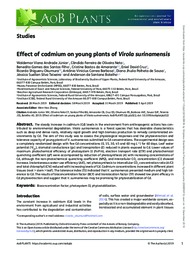Effect of cadmium on young plants of Virola surinamensis.
Effect of cadmium on young plants of Virola surinamensis.
Author(s): ANDRADE JÚNIOR, W. V.; OLIVEIRA NETO, C. F. de; SANTOS FILHO, B. G. dos; AMARANTE, C. B. do; CRUZ, E. D.; OKUMURA, R. S.; BARBOSA, A. V. C.; SOUSA, D. J. P. de; TEIXEIRA, J. S. S.; BOTELHO, A. de S.
Summary: The steady increase in cadmium (Cd) levels in the environment from anthropogenic actions has contributed to environmental degradation. Virola surinamensis is a forest species that has desirable characteristics such as deep and dense roots, relatively rapid growth and high biomass production to remedy contaminated environments by Cd. The aim of this study was to assess the physiological responses and the phytoextraction and tolerance capacity of young plants of V. surinamensis submitted to Cd concentrations. The experimental design was a completely randomized design with five Cd concentrations (0, 15, 30, 45 and 60 mg L−1) for 60 days. Leaf water potential (Ψpd), stomatal conductance (gs) and transpiration (E) reduced in plants exposed to Cd. Lower values of maximum photochemical efficiency of photosystem II (Fv/Fm), electron transport rate (ETR) and photochemical quenching coefficient (qP) were accompanied by reduction of photosynthesis (A) with increasing concentrations of Cd, although the non-photochemical quenching coefficient (NPQ), and intercellular CO2 concentration (Ci) showed increase. Instantaneous water-use efficiency (A/E), net photosynthesis to intercellular CO2 concentration ratio (A/Ci) and total chlorophyll (Chl) reduced with increasing levels of Cd. Cadmium concentrations increased in different plant tissues (root > stem > leaf). The tolerance index (TI) indicated that V. surinamensis presented medium and high tolerance to Cd. The results of bioconcentration factor (BCF) and translocation factor (TF) showed low plant efficacy in Cd phytoextraction and suggest that V. surinamensis may be promising for phytostabilization of Cd.
Publication year: 2019
Types of publication: Journal article
Unit: Embrapa Eastern Amazon
Keywords: Cadmium, Cádmio, Photosystem II, Virola Surinamensis
Observation
Some of Embrapa's publications are published as ePub files. To read them, use or download one of the following free software options to your computer or mobile device. Android: Google Play Books; IOS: iBooks; Windows and Linux: Calibre.
Access other publications
Access the Agricultural Research Database (BDPA) to consult Embrapa's full library collection and records.
Visit Embrapa Bookstore to purchase books and other publications sold by Embrapa.

